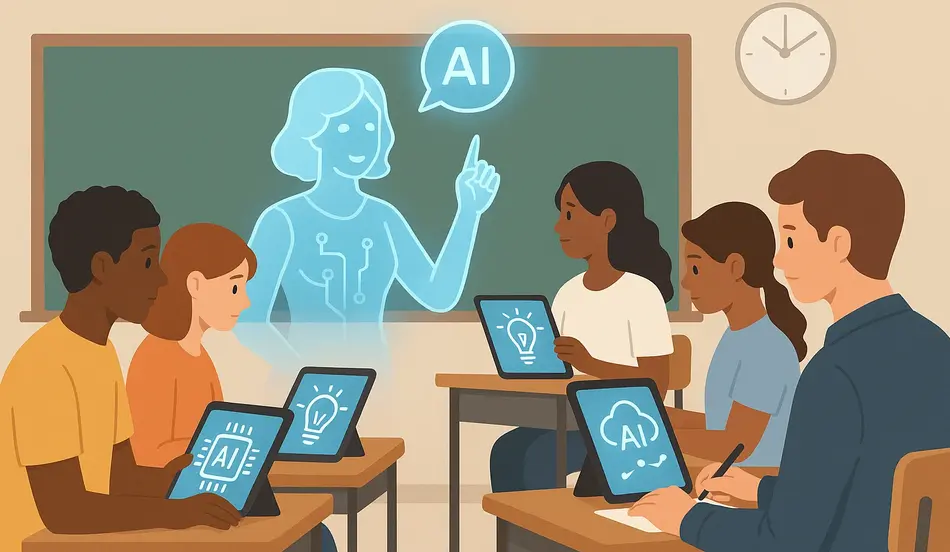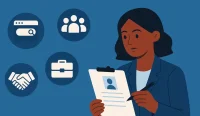The AI education crisis has reached a critical tipping point, with 86% of university students now claiming to use artificial intelligence in their studies. This alarming statistic from a 2024 Digital Education Council survey reveals a fundamental shift in how students approach learning, creating unprecedented challenges for educators and raising serious questions about the future of education.
The crisis became particularly evident when a Spanish teacher in Oklahoma discovered a student had submitted homework written entirely by AI. At the bottom of the page, a telltale sentence stood out: “This summary meets the requirements of the prompt. I hope it is helpful to you.” The student hadn’t even bothered to read what they submitted, highlighting the depth of the AI education crisis we now face.
The Scope of the AI Education Crisis: Alarming Statistics
Student Usage Patterns
The AI education crisis is more widespread than most people realize. According to the Digital Education Council’s 2024 survey, 86% of university students claim to use AI in their studies, with 54% using AI at least on a weekly basis. ChatGPT remains the most popular tool among students.
High School Students Join the Trend
The crisis extends beyond higher education. An ACT study from 2023 found that almost half of high school students reported using AI tools, with ChatGPT again being the most common choice. These tools were most frequently used for language arts assignments and social studies projects.
The Most Concerning Trend
Perhaps the most troubling aspect of the AI education crisis is that students with higher academic performance were significantly more likely to use AI tools than their lower-performing peers. This suggests that academic success may increasingly depend on AI assistance rather than genuine learning and critical thinking skills.
Teacher Adoption and Response
The AI education crisis isn’t limited to students. A 2024 survey from Study.com revealed that 84% of teachers actively use AI in their classrooms, with 65% reporting that AI increased their passion for teaching. However, this positive response was primarily from teachers who received comprehensive AI training.
Government Recognition of the Crisis
In 2023, Congress passed the Artificial Intelligence Literacy Act to support training and programming on artificial intelligence in schools. This legislative response indicates that the AI education crisis has reached the highest levels of government awareness.
The AI Education Crisis in Writing Assignments
Detection Software Reveals the Problem
Software company Turnitin, a popular AI writing detection tool, analyzed over 200 million papers since 2023 and found disturbing results. Approximately 11% of papers had at least 20% AI writing present, while 3% had at least 80% AI writing present.
Student Defiance
A survey by Titan Partners revealed that 75% of students who already use generative AI indicate they will continue to use it even if their professors or institutions ban the technology. This defiance highlights the depth of the AI education crisis and the challenges educators face in maintaining academic integrity.
The Writing Skills Crisis
The AI education crisis is particularly damaging to writing skills development. When students rely on AI to generate essays and assignments, they miss crucial opportunities to develop their own voice, critical thinking abilities, and writing proficiency.
The Voice Problem
AI-generated writing often sounds robotic and lacks the unique voice that students develop through authentic writing practice. This homogenization of student writing represents a significant loss in the educational process.
AI Hallucination: The Misinformation Crisis
Fake Citations and False Information
The AI education crisis extends beyond cheating to include a serious misinformation problem. AI hallucination—where AI systems generate false information, fake citations, and non-existent quotes—poses a significant threat to educational integrity.
Real Examples of AI Hallucination
One North Carolina teacher discovered students had written that “The Christian prophet Moses got chocolate stains out of t-shirts” after using AI for research. Students often lack the background knowledge or intellectual stamina to question these obviously false responses.
Government-Level Impact
The problem isn’t limited to classrooms. The White House’s “Make America Healthy Again” report contained fabricated citations produced by AI, demonstrating that even the highest levels of government aren’t immune to the AI education crisis.
Critical Thinking Implications
The AI education crisis threatens to undermine students’ ability to think critically and evaluate information sources. When students consistently encounter false information from AI tools, they may become either less discerning about all information or overly skeptical of legitimate sources.
Teacher Responses to the AI Education Crisis
Adaptive Strategies
Some educators are responding to the AI education crisis with innovative solutions. Statistics professor Ben Pythri moved to in-class writing for assignments that are strictly writing-based, treating essays like midterm exams.
The Handwritten Solution
This approach forces students into situations where they cannot rely on AI to write for them, ensuring authentic learning experiences. While requiring more grading work, it represents a positive adaptation to the AI education crisis.
AI Training for Teachers
The AI education crisis has prompted widespread training initiatives for educators. One West Coast district introduced “play sessions” to alleviate teachers’ anxiety about AI, followed by instruction-based learning on how to use AI for lesson planning and content generation.
Teacher Usage Patterns
Teachers are using AI for various tasks, from creating worksheets and quizzes to generating grammar practice exercises and even creating AI images to depict key settings in literature like “The Great Gatsby.”
The Grit Crisis: Loss of Perseverance
The Struggle Disappears
Perhaps the most concerning aspect of the AI education crisis is its impact on student perseverance and grit. When students can instantly solve problems with AI, they lose the opportunity to develop resilience and problem-solving skills through struggle.
The Confidence Problem
One teacher noted that the amount of time students are inclined to work on challenging concepts has become much shorter over the past seven years. Students who once wrestled with concepts for days now give up within minutes if they don’t understand something immediately.
The Achievement Gap
The AI education crisis creates a fundamental problem: when students outsource their thinking to AI, they miss the sense of accomplishment that comes from solving difficult problems independently. This achievement gap has serious implications for confidence development and future success.
Potential Solutions to the AI Education Crisis
Balanced Integration
The AI education crisis requires nuanced solutions rather than simple bans. Some educators suggest treating AI like a thesaurus—a tool that helps broaden vocabulary without replacing unique voice and reasoning.
The Calculator Analogy
Some draw parallels between AI and calculators, noting that calculators were initially seen as cheating but are now essential tools. However, the comparison has limitations since calculators help compute faster while AI can replace thinking entirely.
Skills-Based Assessment
To address the AI education crisis, educators are developing new assessment methods that focus on skills that AI cannot easily replicate, such as in-class discussions, presentations, and hands-on projects.
Critical Thinking Focus
Emphasizing critical thinking, problem-solving, and creative skills that require human cognition can help mitigate the negative effects of the AI education crisis while preparing students for a future where AI is ubiquitous.
The Future of the AI Education Crisis
Evolution of Learning
The AI education crisis may ultimately lead to an evolution in how we approach education. Just as calculators changed mathematics education, AI may transform how we teach writing, research, and critical thinking.
Adaptation vs. Resistance
The key question is whether educational institutions can adapt to the AI education crisis by finding ways to integrate AI as a beneficial tool while maintaining academic integrity and genuine learning outcomes.
Long-term Implications
The AI education crisis has implications far beyond the classroom. If students lose the ability to think critically, solve problems independently, and persevere through challenges, society faces a future workforce lacking essential skills.
Related Post: Explore Top Jobs on WhatJobs
Looking for opportunities in this evolving educational landscape? Discover positions that value critical thinking and problem-solving skills:
- Education Technology Specialists: Help schools navigate the AI education crisis with innovative solutions
- Curriculum Developers: Create AI-resistant learning materials that emphasize human skills
- Educational Consultants: Guide institutions through the AI education crisis with strategic planning
- Digital Literacy Instructors: Teach students how to use AI responsibly and critically
- Assessment Specialists: Develop new evaluation methods for the AI era
Hiring? Post Jobs for Free with WhatJobs
Are you an educational institution looking to hire professionals who can help navigate the AI education crisis? Post your job openings for free and connect with experienced educators, technologists, and strategists who understand both the challenges and the transformative opportunities AI brings to learning. WhatJobs helps you find the right people to guide your institution through this pivotal moment in education.
Post a Job Now →Need Career Advice?
“The AI education crisis has reached a critical tipping point, with 86% of university students now claiming to use artificial intelligence in their studies.”
Navigating this rapidly changing educational landscape requires expert guidance. Our career advisors can help you:
- Identify roles that leverage AI while maintaining human skills
- Develop strategies for adapting to AI-driven changes in your field
- Build skills that complement rather than compete with AI
- Find opportunities in education technology and digital learning
- Create career paths that remain relevant in the AI era
Frequently Asked Questions
Q: How widespread is the AI education crisis in schools?
A: The AI education crisis affects 86% of university students and nearly half of high school students, with ChatGPT being the most commonly used tool for completing assignments and research.
Q: What are the main problems caused by the AI education crisis?
A: The AI education crisis creates problems including widespread cheating, loss of critical thinking skills, AI hallucination with false information, and reduced student perseverance and grit when facing challenges.
Q: How are teachers responding to the AI education crisis?
A: Teachers are adapting to the AI education crisis by moving to in-class writing assignments, implementing AI training programs, and developing new assessment methods that focus on skills AI cannot replicate.
Q: What solutions exist for the AI education crisis?
A: Solutions to the AI education crisis include balanced AI integration, skills-based assessment, emphasis on critical thinking, and treating AI as a tool rather than a replacement for human learning and problem-solving.
Q: How does the AI education crisis affect student development?
A: The AI education crisis threatens to undermine students’ ability to think independently, solve problems through struggle, and develop confidence through genuine achievement, potentially creating long-term skill gaps in the workforce.
The AI education crisis represents one of the most significant challenges facing education in the 21st century. While AI offers potential benefits as a learning tool, its current implementation is creating serious problems that require immediate attention from educators, policymakers, and society as a whole. The key to addressing this crisis lies in finding ways to harness AI’s benefits while preserving the essential human skills that education is designed to develop.




